Court of Appeals rules for jurists, but lawmakers cite huge budget deficit
The Albany Times Union by JIMMY VIELKIND - February 24, 2010
ALBANY, NY -- Five judges of the state's highest court said "the independence of the judiciary is improperly jeopardized by the current judicial pay crisis," and legislators should work to give them -- and all of the other judges in the state -- a raise as soon as possible. But the Court of Appeals ruling didn't force the Legislature to increase the pay of about 1,300 judges, and Senate and Assembly leaders don't seem to be in any hurry. By ensuring that any judicial salary increases will be premised on their merits, this holding aims to strike the appropriate balance between preserving the independence of the Judiciary and avoiding encroachment on the budget-making authority of the Legislature," Associate Judge Eugene Pigott wrote in a 39-page decision. "Therefore, judicial compensation, when addressed by the Legislature in present and future budget deliberations, cannot depend on unrelated policy initiatives or legislative compensation adjustments." The court heard arguments last month on three cases that attempted to compel a raise for judges, whose pay has remained the same since 1998. The judges -- who would stand to have their own salaries increased -- heard the case out of "necessity." The majority agreed that a common practice in the budget process, tying judicial pay increases to legislative pay increases, does not pass constitutional muster. Judge Robert Smith dissented. The court stopped short of forcing a pay raise for itself, ruling that a failure to adjust salaries for inflation is not a violation of the duty in the state constitution to compensate judges.
So the fate of judicial pay now stands where it began: before the governor and the Legislature. The Pigott ruling did contain a warning that "it should keep in mind, however, that whether the Legislature has met its constitutional obligations in that regard is within the province of this Court. ... We therefore expect appropriate and expeditious legislative consideration." "The Assembly will consider this matter when economic conditions improve," Speaker Sheldon Silver, D-Manhattan, said in a statement. His staffers said state revenues are growing more slowly than projected. "It is difficult to justify pay raises for anyone in public service," concurred Senate Democratic Conference Leader John Sampson. "Controlling spending among all sectors of government is not an easy decision, but it is the right decision at this time for the people of New York." Through his spokesman, Gov. David Paterson renewed his call for the Legislature to establish a Quadrennial Commission "that periodically would review and adjust judicial compensation." Its recommendations would be submitted to the Legislature for an up-or-down vote "without linkage to any extraneous notions." "The judiciary deserves such a straightforward analytical approach," said Paterson spokesman Morgan Hook. The governor's office also struck a fiscally conservative note: "We note that today's ruling from the Court of Appeals does not order any immediate legislative action. Indeed, considering New York's finances, a full pay raise at this time would be a large burden as we try and close a $8.2 billion deficit," Hook said in a statement. Chief Judge Jonathan Lippman recused himself from the court proceedings, and called the decision "groundbreaking." "The Legislature must now remedy the constitutional violation, and we expect them to do so in good faith and expeditiously," Lippman said in a broadcast address to the state's judges. "We are cognizant of the state's fiscal situation, but that does not detract one iota from the fact that judges have not received so much as a single cost of living adjustment in more than 11 years. If the other branches do not proceed in accordance with the court's decision, I will not hesitate to act in a manner consistent with the constitutional duties and obligations imposed upon me as the head of an independent branch of government." Lippman did not elaborate on what actions he might take. Staff writer Jimmy Vielkind can be reached at 454-5081 or by e-mail at jvielkind@timesunion.com.
Pay for the bench - The base pay of judges in the state ranges from $120,000 to $156,000:
Chief judge: $156,000
Associate judges: $151,000
Appellate Division: $144,000
State Supreme Court: $136,700
County: $137,000-$120,000
Family: $137,000-$120,000
Note: Some judges receive an additional stipend.
***** HERE'S THE DECISION:
Maron v. Silver, 16; Larabee v. Governor, 7; Chief Judge v. Governor, 18
NEW YORK STATE COURT OF APPEALS
Government - New York Law Journal -February 24, 2010
Opinion by Judge Pigott. Judges Ciparick, Graffeo, Read and Jones concur. Judge Smith dissents and votes to affirm in an opinion. Chief Judge Lippman took no part.
Feb. 23, 2010; Case No. 16: Steven Cohn, for appellants; Richard H. Dolan, for respondents; Association of Justices of the Supreme Court of the State of New York, et al., amici curiae
Case No. 17: Richard H. Dolan, for appellants-respondents and respondent; Thomas E. Bezanson, for respondents-appellants; Association of Justices of the Supreme Court of the State of New York, et al.; New York County Lawyers' Association; Atlantic Legal Foundation et al.; Zachary W. Carter; Asian American Bar Association of New York, et al., amici curiae
Case No. 18:Bernard W. Nussbaum, for appellants-respondents; Richard H. Dolan, for respondents-appellants; Fund for Modern Courts; Association of Justices of the Supreme Court of the State of New York, et al., amici curiae
PIGOTT, J.—The constitutional arguments raised in these judicial compensation appeals are premised upon, among other things, alleged violations of the New York State Constitution's Compensation Clause and the Separation of Powers Doctrine. Because the Separation of Powers doctrine is aimed at preventing one branch of government from dominating or interfering with the functioning of another co-equal branch, we conclude that the independence of the judiciary is improperly jeopardized by the current judicial pay crisis and this constitutes a violation of the Separation of Powers Doctrine.
I. Factual Background
The compensation of justices and judges of the Unified Court System, with certain exceptions not applicable here, is governed by article 7-B of the Judiciary Law (see Judiciary Law §§221-221-i). Article VI, section 25-a of the New York Constitution, also known as the "Compensation Clause", directs that the compensation of justices and judges "shall be established by law and shall not be diminished during the term of office for which he or she was elected or appointed." The last time the Legislature adjusted judicial compensation was in 1998, through the amendment of Judiciary Law article 7-B (see L 1998, ch 630 §1, eff. Jan. 1, 1999). That adjustment increased the annual salaries of this State's Judiciary to make them commensurate with the salaries paid their federal counterparts.1 Now, however, New York State ranks nearly last of the 50 states in its level of judicial compensation, adjusting for the cost of living. It is estimated that, over the last eleven years, the real value of judicial salaries has declined by approximately 25 percent to 33 percent. At the time the roughly 1300 judges and justices who comprise the so-called "Article VI judges" (i.e. judges covered by Article VI of the New York State Constitution) received the pay raise that was enacted in 1998, they presided over 3.5 million cases. Ten years later, in 2008, the judges presided over a staggering 4.5 million cases, 38 percent of which were criminal (approximately 1.71 million cases), 42 percent civil (approximately 1.89 million cases), 17 percent family court (approximately 765,000 cases) and 3 percent surrogates court (approximately 135,000 cases) (see New York State Unified Court System, Annual Report 1998 and 2008).
In 2006, the Judiciary submitted to Governor Pataki, as part of its proposed annual budget, a request for $69.5 million to fund salary adjustments for the approximately 1300 Article VI judges, retroactive to April 1, 2005. The intention was to restore pay parity with federal judicial salaries. Although made part of the State budget (see L 2006, ch 51, §2), the Legislature failed to authorize disbursement of the appropriation, because the Legislature and the Governor could not agree on a pay increase for the legislators themselves. The following year, Governor Spitzer included in his Executive Budget more than $111 million for judicial pay raises, retroactive to April 1, 2005, which, if implemented, would have placed salaries of State Supreme Court justices at an amount roughly on a par with federal judicial compensation. The Legislature removed that provision from the budget two months later. In April 2007, the Senate passed a bill (2007 NY Senate Bill S5313) increasing judicial compensation, this time retroactive to January 1, 2007, and calling for the creation of a commission to review future salary increases for both judges and legislators. Governor Spitzer refused to support this legislation, however, unless the Legislature enacted campaign finance and ethics reform measures. Two months later, the Governor expressed support for a "judges only" pay bill. Shortly thereafter, the Senate passed another bill (2007 NY Senate Bill S6550) providing for an increase in judicial salaries, this time without any corresponding increase for legislators. It also called for the establishment of a commission to examine future increases in judicial salaries taking into account the needs of the Judiciary and the State's ability to pay. The Assembly refused to act on that bill because it did not provide for an increase in legislative pay. The following year, Governor Paterson and the Legislature approved a budget for 2008-2009 that included $48 million for judicial salary increases. Like the 2006-2007 appropriation, this was a so-called "dry appropriation" requiring further legislation before the salaries could be paid— legislation that was never enacted. All parties to this litigation agree that Article VI justices and judges have earned and deserve a salary increase. That is what makes this litigation unique. Although the parties have been in accord regarding the need to adjust judicial compensation, the failure of the Legislature and the Executive to come to an agreement on legislation effecting a pay increase has led to the continuing inertia underlying this dispute.
II. Procedural History
Maron v. Silver, et al.
The Maron petitioners—current and former State Supreme Court Justices—commenced this hybrid CPLR article 78 proceeding/declaratory judgment action against respondents Sheldon Silver, as Speaker of the Assembly, Joseph Bruno, then Temporary President of the Senate, Eliot Spitzer, then Governor of New York, Thomas DiNapoli in his capacity as State Comptroller, the Assembly and Senate and the Office of Court Administration.2 The article 78 proceeding seeks mandamus relief compelling the Comptroller to disburse all retroactive sums and pay the budgeted raises allocated in the 2006-2007 state budget for judicial salary reform. The petition also asserts violations of the Separation of Powers Doctrine, equal protection and the state Compensation Clause. Supreme Court, Albany County, partially granted defendants' motion to dismiss the petition for failure to state a cause of action, leaving intact the separation of powers claim. The court further held that Silver, Bruno and Spitzer were immune from suit because setting judicial salaries is a legislative act, and concluded that to the extent the petition alleged a constitutional violation against the Assembly and Senate, those allegations constituted claims against the State.3 In a 4-1 decision, the Appellate Division dismissed the petition, holding, among other things, that the Maron petitioners' failure "to allege a discriminatory attack on the judicial branch that has impaired or imminently threatened the Judiciary's independence and ability to function" was fatal to their separation of powers claim (Maron v. Silver, 58 AD3d 102, 123 [3d Dept 2008]). The Maron petitioners appealed to this Court as of right on the constitutional questions presented. This Court retained jurisdiction over the appeal and denied leave to appeal as unnecessary (see Maron v. Silver, 12 NY3d 909 [2009]).
Larabee v. Governor, et al.
The Larabee plaintiffs—members of the New York State Judiciary—commenced this declaratory judgment action against Eliot Spitzer, in his capacity as Governor, the New York State Assembly and Senate, and the State, alleging violations of the state Compensation Clause and the Separation of Powers Doctrine. Supreme Court, New York County, granted the State defendants' motion to dismiss the Compensation Clause cause of action but, similar to the Supreme Court in Maron, concluded that the Larabee plaintiffs had sufficiently pleaded a separation of powers claim (see Larabee v. Spitzer, 19 Misc 3d 226, 231-237 [Sup Ct, New York County 2008]). Supreme Court dismissed the complaint in its entirety as against Governor Spitzer, noting that the Larabee plaintiffs conceded that he was not an "essential party" to the action, all parties having agreed that the Assembly, Senate and State were proper parties (see id. at 237-239). Supreme Court subsequently granted the Larabee plaintiffs summary judgment on the separation of powers cause of action (see Larabee v. Governor, 20 Misc 3d 866, 877 [Sup Ct, New York County 2008]). The State defendants appealed from that order and the Larabee plaintiffs cross-appealed from Supreme Court's order dismissing their Compensation Clause claim. The Appellate Division affirmed both orders (Larabee v. Governor, 65 AD3d 74 [1st Dept 2009]). The Larabee plaintiffs and State defendants appealed as of right and we retained jurisdiction.
Chief Judge v. Governor, et al.
The Chief Judge plaintiffs—former Chief Judge Judith S. Kaye4 and the New York State Unified Court System—commenced this declaratory judgment action asserting three causes of action against David Paterson, Sheldon Silver, Joseph Bruno, all in their respective official capacities, and the Assembly, Senate and State. The complaint asserts one cause of action premised on a violation of the state Compensation Clause under a different theory than that posed by the Maron and Larabee plaintiffs; namely, that the diminution in judicial salaries has had a discriminatory effect on the Judiciary, rendering unconstitutional the salaries codified in Judiciary Law §§221 through 221-i. The two remaining claims are grounded on the Separation of Powers Doctrine. One of the claims is similar to those raised in the Maron and Larabee litigation; the other is premised on the theory that the Judiciary cannot function as a co-equal branch if it is not assured of receiving "adequate compensation," and that the judicial salaries codified in Judiciary Law §§221-221-i are constitutionally insufficient. The State defendants moved to dismiss the complaint for failure to state a cause of action. Supreme Court, New York County, searched the record and granted the Chief Judge plaintiffs summary judgment on the separation of powers claim that was similar to the one raised in Larabee, but dismissed the remaining causes of action attacking the constitutionality of Judiciary Law §§221-221-i (see Chief Judge v. Governor, 25 Misc 3d 268, 271-273 [Sup Ct, New York County [2009]). As in Larabee, Supreme Court dismissed the complaint in its entirety as against the Governor (see id. at 271-272). The State defendants appealed to the Appellate Division, which affirmed for the reasons stated in Larabee (see Chief Judge v. Governor, 65 AD3d 898, 898 [1st Dept 2009]). The Chief Judge plaintiffs appealed Supreme Court's order directly to this Court pursuant to CPLR 5601(b)(2) and we retained jurisdiction over the appeal. Because the Chief Judge plaintiffs challenged the constitutionality of the judicial salaries set forth in Judiciary Law §§221-221-i, the direct appeal from the order of Supreme Court was proper.5 The State defendants appealed as of right from the Appellate Division's affirmance of Supreme Court's order granting the Chief Judge plaintiffs summary judgment on the separation of powers claim.
III. Rule of Necessity
Members of the Court of Appeals are paid via the salary schedule delineated in Judiciary Law §221 and therefore will be affected by the outcome of these appeals. Ordinarily, when a judge has an interest in litigation, recusal is warranted. But this case falls within a narrow exception to that rule. Because no other judicial body with jurisdiction exists to hear the constitutional issues raised herein, this Court must hear and dispose of these issues pursuant to the Rule of Necessity (see Maresca v. Cuomo, 64 NY2d 242, 247 n 1 [1984], appeal dismissed 474 US 802 [1985] [addressing a challenge to the state Constitution's mandatory retirement age requirements for certain state judges] citing Matter of Morgenthau v. Cooke, 56 NY2d 24, 29 n 3 [1982]).
IV. Non-Constitutional Statutory Claim (Maron Petitioners Only)
The Maron petitioners assert that the constitutional issues raised on these appeals can be avoided should this Court find that they are entitled to relief in the nature of mandamus compelling the Comptroller to pay the $69.5 million appropriated in the 2006-2007 state budget. As support for this argument, petitioners focus on chapter 51 of the laws of 2006 addressing "Judicial Compensation Reform." That provision contained a $69.5 million budget item "[f]or expenses necessary to fund adjustments in the compensation of state-paid judges and justices of the unified court system pursuant to a chapter of the laws of 2006" (emphasis supplied). Petitioners claim that the Comptroller improperly impounded these funds and should be ordered to release them to provide for judicial salary increases. A CPLR article 78 proceeding seeking mandamus to compel the performance of a specific duty applies only to acts that are ministerial in nature and not those that involve the exercise of discretion (see Gimprich v. Board of Educ. of City of N.Y., 306 NY 401, 406 [1954]; see also Siegel, NY Prac §558, at 958 [4th ed]). Because of the constitutional requirement that judicial compensation be "established by law" (NY Const, art VI, §25 [a]), mandamus does not lie in this instance because no subsequent chapter law was enacted either amending the Judiciary Law salary schedules or directing the disbursement of the funds. The $69.5 million referenced in the Judicial budget was explicitly made contingent upon the adoption of additional legislation, i.e. a chapter of the laws of 2006. Had the Legislature intended that the judicial compensation appropriation be self-executing, as petitioners claim, there would have been no need for the qualifying language. Moreover, a mere provision calling for a lump sum payment of $69.5 million without repeal or revision of the Judiciary Law article 7-B judicial salary schedules is further evidence that additional legislation was required before the funds could be disbursed. We, therefore, conclude that the Appellate Division properly dismissed petitioners' cause of action seeking mandamus against the Comptroller.
V. Constitutional Claims (All Litigants)
A. Equal Protection
The Judiciary as a "Suspect Class" (Maron Petitioners)
The Maron petitioners are the only litigants in these appeals who have alleged that the Judiciary constitutes a "suspect class" that has been denied equal protection under the law because judicial pay raises have been historically contingent on or "tied to" salary increases for legislators. They also assert that the State defendants' rationale for refusing to increase judicial salaries fails to pass the "strict scrutiny" test or the less stringent rational basis test. For the reasons set forth in the Appellate Division order, we conclude that Supreme Court properly dismissed that cause of action (see Maron, 58 AD3d at 123-124).
B. Compensation Clause
The Maron petitioners and the Larabee plaintiffs assert Compensation Clause causes of action that are premised on their claims that judicial salaries have been unconstitutionally diminished because of inflation. The Chief Judge plaintiffs posit an additional argument, asserting that the Legislature's act of freezing judicial salaries while increasing the salaries of 195,000 other state employees amounted to discrimination against the Judiciary.
Diminution by "Pure Inflation" (Maron and Larabee)
The state Compensation Clause provides, in relevant part, that the compensation of members of the Judiciary "shall be established by law and shall not be diminished during the term of office for which he or she was elected or appointed" (NY Const, art VI, §25 [a]). The purpose of this "Compensation Clause" is the same as its federal counterpart: to promote judicial independence and ensure that the pay of prospective judges, who choose to leave their practices or other legal positions for the bench, will not diminish (see United States v. Will, 449 US 200, 221 [1980]). The Maron petitioners and Larabee plaintiffs base their Compensation Clause arguments on an identical theory: By failing to increase judicial compensation, the Legislature has allowed inflation to considerably diminish the "real value" of judicial salaries, violating the state Compensation Clause's prohibition against diminution. They further claim that the state Compensation Clause's prohibition against diminishment should include the diminishment of compensation by any cause, including inflation. Since the inception of our State Constitution, this State has grappled with the issue of how best to establish the parameters of judicial compensation. In 1846, the Constitutional Convention adopted the phrase "shall not be increased or diminished"; an 1869 amendment, however, deleted the words, "increased or," allowing for the increase of compensation, but not a decrease (see Carter, New York State Constitution: Sources of Legislative Intent, at 85 [1988]). The 1894 Constitution restored the 1846 "shall not be increased or diminished" language, which was thereafter deleted in its entirety in 1909 and adopted a specific constitutional provision fixing salaries for certain judges at $10,000 per year (see Matter of Gresser v. O'Brien, 146 Misc 909, 917-918 [Sup Ct, New York County 1933], affd 263 NY 622 [1934]). In 1921, a Judiciary Constitutional Convention was held to consider, among other things, amendments to the state Constitution concerning judicial compensation (see Judiciary Constitutional Convention of 1921: Report to Legislature, at 3 [1/4/22]). The Convention criticized the 1909 Compensation Clause amendment's inclusion of a salary schedule in the Constitution, stating that judicial compensation "'should, in the judgment of the present convention, be left entirely to the legislature, which after all is the body always directly in touch with and responsible to the people'" (New York State Constitutional Convention Committee, Problems Relating to Judicial Administration and Organization, at 339 [1938], quoting Judiciary Constitutional Convention of 1921: Report to Legislature, at 29).
In recommending removal of the salary schedule, the Convention considered the deleterious effects of inflation on judicial compensation and how it could negatively impact the independence and effectiveness of the Judiciary, ultimately concluding that the Legislature was in the best position to address that issue (see Judiciary Constitutional Convention of 1921: Report to Legislature, at 29). In 1925, the state Compensation Clause's "shall not be diminished" language was reinstated and remains unchanged (see Carter, at 85). It is evident from the events pre-dating the 1925 amendment that the concept of diminution of compensation was of paramount concern, and the final outcome was to authorize the Legislature to remedy any deficiencies; notably, the Legislature was precluded from diminishing salaries in recognition of the risk that salary manipulation might be used as a tool to retaliate for unpopular judicial decisions. Although the state Compensation Clause plainly prohibits the diminution of judicial compensation by legislative act during a judge's term of office, there is no evidence in the history of the Clause's enactment or subsequent amendments that supports a broad interpretation embracing indirect diminishment by neglect. Thus, there is no evidence that the state Compensation Clause's "no diminishment" rule was intended to affirmatively require that judicial salaries be adjusted to keep pace with the cost of living.6 In this regard, the state provision is comparable to the federal Compensation Clause (US Const, art III, §1) which also contains the same "shall not be diminished" language. Like the drafters of the state Compensation Clause, the Framers of the federal Constitution were cognizant of the effects of inflation on judicial compensation, but nonetheless left that determination to the discretion of the Legislature.
At least two proposals concerning inflation were offered at the federal Constitutional Convention. One suggestion was that the fluctuations in the value of judicial compensation could be accounted for "by taking for a standard wheat or some other thing of permanent value" (2 M. Farrand, The Records of the Federal Convention of 1787, at 45 [1911]). The other suggestion left judicial compensation to the discretion of the Legislature, which was in a better position to address inflationary concerns (see Will, 449 US at 219-220, supra; see also Hamilton, Federalist No. 79 ["It (is) therefore necessary to leave it to the discretion of the legislature to vary (compensation) in conformity to the variations in circumstances, yet under such restrictions as to put it out of the power of that body to change the condition of the individual for the worse"]). The latter approach carried the day, with the Convention adopting a motion to allow an increase of judicial compensation by Congress and, as a result, "accepting a limited risk of external influence in order to accommodate the need to raise judges' salaries when times changed" (Will, 449 US at 220). Contrary to the contention of the Maron petitioners and Larabee plaintiffs, federal jurisprudence does not support their assertion that the state and federal Compensation Clauses prohibit "indirect" diminution of compensation due to inflation. Although the cases cited support the general proposition that judicial compensation may not be either "directly" or "indirectly" reduced, none of them stands for the proposition that the Legislature's failure to adjust compensation to account for inflation constitutes an indirect attack on judicial compensation. In Evans v. Gore, a federal judge challenged, on federal Compensation Clause grounds, Congress's authority to include sitting federal judges within the scope of a federal income tax law that the Sixteenth Amendment had authorized years earlier, claiming that the imposition of such a tax constituted a diminishment in salary (see 253 US 245, 247 [1920], overruled by United States v. Hatter, 532 US 557 [2001]). In finding the tax violative of the federal Compensation Clause, the Evans court noted that "diminution may be effected in more ways than one. Some may be direct and others indirect and even evasive… But all which by their necessary operation and effect withhold or take from the judge a part of that which has been promised by law for his services must be regarded as within the prohibition" (id. at 254). In Miles v. Graham, the United States Supreme Court extended the Evans holding to those judges who assumed office after the tax had become law (see Miles v. Graham, 268 US 501, 508-509 [1925], overruled in part by O'Malley v. Woodrough, 307 US 277 [1939]). The O'Malley court overruled Miles, but left the core holding of Evans intact (see O'Malley, 307 US at 282-283). However, the Supreme Court in United States v. Hatter overruled Evans "insofar as it holds that the Compensation Clause forbids Congress to apply a generally applicable, nondiscriminatory tax to the salaries of federal judges, whether or not they were appointed before enactment of the tax" (Hatter, 532 US at 567). The Hatter court agreed with Evans, however, "insofar as it holds that the Compensation Clause offers protections that extend beyond a legislative effort directly to diminish a judge's pay, say, by ordering a lower salary… Otherwise a legislature could circumvent even the most basic Compensation Clause protection by enacting a discriminatory tax law, for example, that precisely but indirectly achieved the forbidden effect" (id. at 569 [emphasis supplied]). The evolution of Supreme Court jurisprudence from Evans to Hatter establishes that a nondiscriminatory tax that treats judges the same as other citizens is permissible, but direct diminution of compensation or the discriminatory taxation of judges is not. In either case, it is the diminishment of salary by Congress, be it direct or indirect, that is prohibited. Here, the Legislature has not enacted legislation that has directly diminished judicial compensation in violation of the state Compensation Clause, nor has it enacted discriminatory legislation that has indirectly resulted in the diminution of judicial compensation. The claim is that inflation has had this effect. However, at least as far as the federal Compensation Clause is concerned, the intention of the Framers was that Congress would serve as the failsafe that prevents inflation from eating away at the real value of judicial salaries (see Atkins v. United States, 556 F2d 1028, 1048 [US Ct of Claims 1977] cert denied 434 US 1009 [1978] [addressing inflation]). There is no reason for this Court to depart from that rationale, because it is evident from the history surrounding the enactment of our state Compensation Clause that, although the diminution in value of judicial compensation by inflation was a concern, the drafters decided that the best way to combat the effects of inflation was to count on the Legislature—the body directly accountable to the public—to assure the fair and appropriate compensation of the judiciary. We therefore determine that the Legislature's failure to address the effects of inflation in this case does not equate to a per se violation of the Compensation Clause.
Compensation Clause—Discrimination (Chief Judge)
The Chief Judge plaintiffs' Compensation Clause argument is distinctly different from the claims raised by the other litigants. Rather than contending that inflation resulted in the unconstitutional diminution of judicial salaries, they assert that by freezing judicial salaries while repeatedly increasing the salaries of almost all of the remaining 195,000 state employees to keep pace with the cost of living, the State defendants discriminated against the Judiciary in violation of the state Compensation Clause. This argument is premised exclusively on the Supreme Court's holding in Hatter (532 US 557, supra), which involved a Social Security tax law that, at the time of its enactment, mandated that all newly-hired federal employees participate in the Social Security program. The law also offered almost all of the then-currently employed federal employees (96 percent) the option to participate without any additional financial obligation. But it created an exception for the remaining four percent of currently employed federal employees, however, which required members of that class—who contributed to a "covered" retirement program—to participate in the system without any further additional financial obligation. The legislation left those who did not participate in a "covered" program (i.e., a group consisting "almost exclusively" of federal judges) without a choice; their financial obligations and payroll deductions would increase as a result of the imposition of the new tax (id. at 562-564). In finding the law violative of the federal Compensation Clause as discriminatory against judges, the Hatter court noted that the Social Security legislation was "special—in its manner of singling out judges for disadvantageous treatment, in its justification as necessary to offset advantages related to constitutionally protected features of the judicial office, and in the degree of permissible legislative discretion that would have to underlie any determination that the legislation has 'equalized' rather than gone too far." It was these elements that made the Social Security tax distinctly different from a nondiscriminatory tax (id. at 576). According to the Chief Judge plaintiffs, just as the Social Security tax law in Hatter imposed a discriminatory tax on the Judiciary, inflation has the same impact on judicial compensation as a tax and, although the failure to remedy it in and of itself may not violate the state Compensation Clause, in this case the Judiciary has been singled out because nearly all of the other 195,000 state employees have received salary increases to compensate in part for inflation. We are unpersuaded that relief is warranted under the Hatter analysis. First, Hatter involved a legislative enactment that discriminated against federal judges by reducing the compensation of judges only; the situation here does not involve any legislative enactment that directly or indirectly diminishes judicial compensation. Second, although other state employees have received adjustments to account for inflation, judges are not the only state employees whose salaries have not been adjusted; the Governor, Lieutenant Governor, members of the Legislature and other constitutional officers have also not received salary increases since 1999. We therefore cannot say that judges have been disadvantaged in a manner comparable to the discriminatory treatment in Hatter. Therefore, Supreme Court properly dismissed this cause of action.
C. Separation of Powers
Speech or Debate Clause Defense (State Defendants)
Before we address plaintiffs' separation of powers arguments, we consider the legislative defendants' primary defense that both houses of the Legislature and their leaders are immune from any such claim under the Speech or Debate Clause. The state Speech or Debate Clause provides that "[f]or any speech or debate in either house of the legislature, the members shall not be questioned in any other place" (NY Const, art III, §11). The scope of immunity this provision bestows upon members of the Legislature provides "as much protection as the immunity granted by the comparable provision of the Federal Constitution" (People v. Ohrenstein, 77 NY2d 38, 53 [1990] [citation omitted]), and "protects against inquiry into acts that occur in the regular course of the legislative process and into the motivation for those acts" (United States v. Brewster, 408 US 501, 525 [1972]). The Appellate Division in Maron dismissed the separation of powers cause of action because, to the extent the Legislature failed to either increase judicial compensation due to inaction or because it tied such increases to "political wrangling over unrelated issues," such failure constitutes a legislative function protected by article III, §11 (Maron, 58 AD3d at 121-123). The courts in Larabee and Chief Judge, however, concluded that the Speech or Debate Clause did not bar review. The Speech or Debate Clause applies to only "members" and to "any speech or debate in either house." Nowhere does the Clause state that such immunity applies to either house of the Legislature as a whole, and therefore, it does not apply to the Assembly or the Senate. For the same reason, the State may not assert this defense. In any event, all of the parties acknowledge that the Judiciary is entitled to an increase in compensation, and the State defendants have made proclamations outside of the Legislative and Executive Chambers as to why such an increase has not occurred (see e.g. Ohrenstein, 77 NY2d at 54 [issuance of press releases and newsletters deemed not protected legislative acts]; see also Rivera v. Espada, 98 NY2d 422, 428 [2002] [same]; Hutchinson v. Proxmire, 443 US 111 [1979]). As a result, this Court need not inquire "into acts that occur in the regular course of the legislative process" or the Legislature's motives for such acts (see Brewster, 408 US at 525), eliminating the danger of the Judiciary intruding upon the independence of the legislative branch. We therefore address the merits of the separation of powers arguments. Failure by Legislature to Independently and Objectively Consider Compensation Increases (Maron, Larabee and Chief Judge)
The Maron petitioners and the Larabee and Chief Judge plaintiffs all make the same separation of powers argument: By tying judicial compensation to unrelated legislative objectives and policy initiatives, as opposed to conducting an independent assessment of judicial compensation, the Legislature has disregarded the Separation of Powers Doctrine and threatened the independence of the Judiciary. The State defendants counter that there is nothing in the constitutional text or framework prohibiting the Legislature from considering judicial compensation along with other prerogatives. Furthermore, any declaration condemning that practice as unconstitutional would itself constitute a separation of powers violation by the Judiciary through intrusion into budgetary and appropriations processes. In Maron, the Appellate Division dismissed petitioners' claim on the ground that their failure "to allege a discriminatory attack on the judicial branch that has impaired or imminently threatened the Judiciary's independence and ability to function" was fatal to the claim (Maron, 58 AD3d at 123). This claim met with greater success in Larabee and Chief Judge, where the Appellate Divisions in each of those cases upheld the Supreme Court's award of summary judgment to those plaintiffs (see Chief Judge, 65 AD3d 898, 898 [1st Dept 2009]; Larabee, 65 AD3d at 74).
The concept of the separation of powers is the bedrock of the system of government adopted by this state in establishing three co-ordinate and co-equal branches of government, each charged with performing particular functions (see generally Under 21, Catholic Home Bur. for Dependent Children v. City of New York, 65 NY2d 344, 355-356 [1985]; Oneida County v. Berle, 49 NY2d 515, 522 [1980]). The Constitution's aim "is to regulate, define and limit the powers of government by assigning to the executive, legislative and judicial branches distinct and independent powers," thereby ensuring "an even balance of power [among] the three" (People ex rel. Burby v. Howland, 155 NY 270, 282 [1898]). The separation of the three branches is necessary "'for the preservation of liberty itself,'" and "'[i]t is a fundamental principle of the organic law that each department should be free from interference, in the discharge of its peculiar duties, by either of the others'" (Berle, 49 NY2d at 522 quoting Burby, 155 NY at 282). To accomplish this important goal, Articles III, IV and VI of the state Constitution address the respective powers conferred upon, and respective compensation of, the Legislature, Executive and Judiciary. Article III states that "[t]he legislative power of this state shall be vested in the senate and the assembly" (NY Const, art III, §1), and that "[e]ach member of the legislature shall receive for his or her services a like annual salary, to be fixed by law…[but] the salary of any member…may [not] be increased or diminished during, and with respect to, the term for which he or she shall have been elected" (NY Const, art III, §6). Article IV states that "[t]he executive power shall be vested in the governor, who shall hold office for four years" (NY Const, art IV, §1), and who "shall receive for his or her services an annual salary to be fixed by joint resolution of the senate and assembly" (NY Const, art IV, §3). Article VI states that "[t]here shall be a unified court system of the state" (NY Const, art VI, §1) and that the compensation of judges and justices within that system "shall be established by law and shall not be diminished during the term of office for which he or she was elected or appointed" (NY Const, art VI, §25 [a]). We find it significant that the compensation provisions for each branch of government are not contained in Article III where the powers of the legislative branch are articulated, but rather are separately addressed in the article for each respective branch. Although a function of the Legislature is to approve the compensation of each of the three branches, this fact underscores only the checks and balances of the system; it does not rebut the fact that the compensation to be paid to members of each particular branch must be determined separately and distinctly from the others. Indeed, whether the Judiciary is entitled to a compensation increase must be based upon an objective assessment of the Judiciary's needs if it is to retain its functional and structural independence. Simply put, by failing to consider judicial compensation increases on the merits, and instead holding it hostage to other legislative objectives, the Legislature "[w]eaken[s the Judiciary]…by making it unduly dependent" on the Legislature (Burby, 155 NY at 282).
Separate budgets, separate articles in the Constitution, and separate provisions concerning compensation are all testament to the fact that each branch is independent of the other. This, of course, does not mean that the branches operate without concern for the other. Both the Legislature and the Governor rely on the good faith of the other and of the Judiciary for the good of the State. As members of the two "political" branches, the Governor and Legislature understandably have the power to bargain with each other over all sorts of matters including their own compensation. Judges and justices, on the other hand, are not afforded that opportunity. They have no seat at the bargaining table and, in fact, are precluded from participating in politics. The judicial branch therefore depends on the good faith of the other two branches to provide sufficient funding to fulfill its constitutional responsibilities. Given its unique place in the constitutional scheme, it is imperative that the legitimate needs of the judicial branch receive the appropriate respect and attention. This cannot occur if the Judiciary is used as a pawn or bargaining chip in order to achieve ends that are entirely unrelated to the judicial mission. For instance, the Constitution prohibits legislators from increasing or decreasing their own salaries during their two-year term of office, but there is no such prohibition against the Legislature addressing judicial compensation at any time. Moreover, state legislators are part-time and may supplement their income through committee assignments, leadership positions and other outside employment. Judges are constitutionally forbidden from engaging in any employment that would interfere with their judicial responsibilities (see NY Const, art VI, §2 [b] [4]). But by failing to consider judicial compensation independently of legislative compensation, the State defendants have imposed upon the Judiciary the same restrictions that have been imposed on the Legislature, and have blurred the line between the compensation of the two branches, thereby threatening the structural independence of the Judiciary.
The State defendants assert that it is within their legislative rights to consider judicial compensation not on the merits but relative to unrelated policy initiatives. But they overlook the fact that they are treating judicial compensation—which falls within the scope of their constitutional duties—as if it were merely another government program appropriation as opposed to compensation for members of a co-equal branch. We do not attribute the State defendants' failure to increase judicial compensation to any nefarious purpose. Indeed, it is not necessary to consider, or find, the existence of any improper motive. All parties agree that a salary increase is justified and, yet, those who have the constitutional duty to act have done nothing to further that objective due to disputes unrelated to the merits of any proposed increase. This inaction not only impairs the structural independence of the Judiciary, but also deleteriously affects the public at large, which is entitled to a well-qualified, functioning Judiciary (see O'Donoghue v. United States, 289 US 516, 533 [1933] [prohibition against diminution is to attract competent people to the bench, promote independence of the Judiciary, and for the public interest]).
It must be remembered that the Separation of Powers Doctrine "is a structural safeguard rather than a remedy to be applied only when specific harm, or risk of specific harm, can be identified. In its major features…it is a prophylactic device, establishing high walls and clear distinctions because low walls and vague distinctions will not be judicially defensible in the heat of interbranch conflict" (Plaut v. Spendthrift Farm, Inc., 514 US 211, 239 [1995] [emphasis in original]). Here, the allegations by the Maron petitioners are sufficient to state a separation of powers claim. As that case is here before us on a CPLR 3211 motion to dismiss, our corrective action is limited to a reinstatement of that cause of action. In Larabee and Chief Judge, the procedural posture of the cases is not so limiting and we may now issue a declaration. We hold that under these circumstances, as a matter of law, the State defendants' failure to consider judicial compensation on the merits violates the Separation of Powers Doctrine. However, when "fashioning specific remedies for constitutional violations, we must avoid intrusion on the primary domain of another branch of government" (Campaign for Fiscal Equity, Inc. v. State of New York, 8 NY3d 14, 28 [2006]). Indeed, deference to the Legislature—which possess the constitutional authority to budget and appropriate—is necessary because it is "in a far better position than the Judiciary to determine funding needs throughout the state and priorities for the allocation of the State's resources" (id. at 29). The Judiciary may intervene in the state budget "only in the narrowest of instances" (Wein v. Carey, 41 NY2d 498, 505 [1977]), and we do not believe that it is necessary here to order specific injunctive relief. When this Court articulates the constitutional standards governing state action, we presume that the State will act accordingly.
Failure to Provide Adequate Compensation (Chief Judge)
The Chief Judge plaintiffs make a separation of powers claim not raised by the Maron petitioners or Larabee plaintiffs: The separation of powers doctrine requires that the State defendants provide the Judiciary with "adequate judicial compensation" and, because judicial salaries are constitutionally inadequate, the State defendants have breached their constitutional duty. The constitutional inadequacy of judicial salaries, the Chief Judge plaintiffs posit, threatens to impair the Judiciary's ability to function as a co-equal branch. The Compensation Clause was enacted to preserve judicial independence, and we agree with the conclusion of high courts in other jurisdictions that this is dependent, in part, on judges receiving adequate compensation (see Glancy v. Casey, 447 PA 77, 86 [1972] ["it is the constitutional duty and the obligation of the legislature, in order to insure the independence of the judicial…branch of government, to provide compensation adequate in amount and commensurate with the duties and responsibilities of the judges involved"]). Moreover, adequate judicial compensation is necessary to ensure that the public will have its matters heard by competent judges (see Judiciary Constitutional Convention of 1921: Report of the Legislature, at 29, supra) and that judges will be free to issue decisions in accordance with the law without fear of retribution by the other two branches of government. Therefore, we reject the State defendants' claim that the Compensation Clause's language that compensation "shall not be diminished" is the opposite of an "adequate compensation" guarantee. Even counsel for the State defendants in Larabee concede that judicial compensation "could be so low that it could be constitutionally objected to."
The Chief Judge plaintiffs posit that the current salaries of Judiciary Law article 7-B judges and justices are inadequate when compared to other legal positions in the public and private sectors. This argument is one that is best addressed in the first instance by the Legislature. All of the State defendants have conceded, at one point or another, that judicial compensation must be increased. We anticipate that our holding today will permit them to consider, in good faith, judicial salary increases on the merits. The Legislature might find the record compiled in the Chief Judge case to be helpful. There, plaintiffs demonstrate— without rebuttal from the State—that, in real value, New York judges' salaries now rank below judicial salaries in other states and the federal judiciary, despite the complexity of legal issues presented in New York—a world economic center—and the burgeoning case load faced by New York judges. The argument for a cost-of-living increase is not that, in some objective sense, New York Judges do not earn a living wage. Judges made no such argument when this litigation commenced in much better economic times and certainly do not press such a contention now. The claim is that, due to the lack of a cost-of-living increase for more than 11 years, judges no longer earn salaries that are appropriate given the significance of their position in our tri-partite form of government and the role they play in ensuring the rights of all members of society. That role has increased substantially since the last compensation adjustment. For instance, the Judiciary's workload has increased by 10 percent over the past four years alone. Since 2005, Family Court's workload has increased 16 percent, civil filings in Supreme Court have increased more than 14 percent, and the caseloads in the New York City Civil Courts and those city courts outside of New York City have risen by 13 and 17 percent, respectively. Moreover, state courts handle over 90 percent of the filings as compared to the less than 10 percent handled by our federal courts. Judicial salaries need not be exorbitant, but they must be sufficient to attract well-qualified individuals to serve. Otherwise, only those with means will be financially able to assume a judicial post, negatively impacting the diversity of the Judiciary and discriminating against those who are well qualified and interested in serving, but nonetheless unable to aspire to a career in the Judiciary because of the financial hardship that results from stagnant compensation over the years.
IV. Conclusion
It is unfortunate that this Court has been called upon to adjudicate constitutional issues relative to an underlying matter upon which all have agreed; namely, that the Judiciary is entitled to a compensation adjustment. By ensuring that any judicial salary increases will be premised on their merits, this holding aims to strike the appropriate balance between preserving the independence of the Judiciary and avoiding encroachment on the budget-making authority of the Legislature. Therefore, judicial compensation, when addressed by the Legislature in present and future budget deliberations cannot depend on unrelated policy initiatives or legislative compensation adjustments. Of course, whether judicial compensation should be adjusted, and by how much, is within the province of the Legislature. It should keep in mind, however, that whether the Legislature has met its constitutional obligations in that regard is within the province of this Court (see Marbury v. Madison, 1 Cranch 137, 177 [1803]). We therefore expect appropriate and expeditious legislative consideration. Accordingly, In Maron, the order of the Appellate Division should be modified, without costs, by remitting to Supreme Court for further proceedings in accordance with this opinion, and as so modified, affirmed. In Larabee, the order of Appellate Division should be modified, and in Chief Judge, the judgment of Supreme Court and the order of the Appellate Division should be modified, without costs, by granting judgment declaring that under the circumstances of these cases, as a matter of law, the State defendants' failure to consider judicial compensation on the merits violates the Separation of Powers Doctrine, and by allowing for the remedy discussed in this opinion, and, as modified, affirmed.
SMITH, J. (dissenting)—I share my colleagues' dismay at the Legislature's behavior in dealing with, or rather failing to deal with, judges' salaries, but I cannot agree that any of its actions or inactions are unconstitutional. The majority holds that the Legislature has violated the separation of powers by its failure to consider judicial salaries "based upon an objective assessment of the Judiciary's needs" (op at 27) or to give "appropriate respect and attention" to the needs of the judicial branch (op at 28). Undoubtedly, all branches of government should evaluate each other's needs objectively and treat each other with respect, but I know no warrant for thinking that objectivity and respect are commanded by the Constitution. These qualities are so amorphous and subjective that they can provide no workable standard for constitutional decision-making. As the Appellate Division in Maron put it, "nothing in the NY Constitution forbids the political branches from engaging in politics when carrying out their political functions" (Maron v. Silver, 58 AD3d 102, 122 [3d Dept 2008]). Separation of powers is violated not when one of the three branches acts irresponsibly—that happens all the time—but when one threatens the place of another in the constitutional scheme. Thus I might well agree that separation of powers was violated if the actual or imminent effect of the Legislature's conduct were to make the recruitment of competent judges impossible, or to render judges subservient to the other branches of government. I need not expand on this point; it is well explained both in the Appellate Division's Maron opinion (58 AD3d at 116-23)and in Atkins v. United States (556 F2d 1028, 1054-57 [Ct Cl 1977], cert denied 434 US 1009 [1978]), a federal case involving facts much like those before us now. Bad as the present situation is, neither of the disastrous conditions I have mentioned—a bench that cannot be filled with competent people, or one whose financial dependence makes it the slave of the Legislature —exists or is close to existing. It is a depressing truth that some of our finest judges have left, or are thinking of leaving, their jobs because of the Legislature's failure to deal with the salary issue; but it is also true that there are still plenty of able judges, and plenty of able people who would willingly become judges, even at today's pay levels. And I have seen no evidence of judicial subservience to the Legislature; the problem, if there is one, is to restrain judges' understandable displeasure with that branch of our government. I would affirm the Appellate Division order in Maron, and would modify the orders in Larabee and Chief Judge to dismiss all claims in the complaints.
Case No. 16: Order modified, without costs, by remitting to Supreme Court, Albany County, for further proceedings in accordance with the opinion herein. Opinion by Judge Pigott. Judges Ciparick, Graffeo, Read and Jones concur. Judge Smith dissents and votes to affirm in an opinion. Chief Judge Lippman took no part.
Case No. 17: Order modified, without costs, by granting judgment declaring that, under the circumstances of this case, as a matter of law, the State defendants' failure to consider judicial compensation on the merits violates the separation of powers doctrine, and by allowing for the remedy discussed in the opinion herein, and, as so modified, affirmed. Opinion by Judge Pigott. Judges Ciparick, Graffeo, Read and Jones concur. Judge Smith dissents in an opinion. Chief Judge Lippman took no part.
Case No. 18: On plaintiffs' appeal and defendants' cross appeal, judgment of Supreme Court and order of the Appellate Division modified, without costs, by granting judgment declaring that, under the circumstances of this case, as a matter of law, the State defendants' failure to consider judicial compensation on the merits violates the separation of powers doctrine, and by allowing for the remedy discussed in the opinion herein, and, as so modified, affirmed. Opinion by Judge Pigott. Judges Ciparick, Graffeo, Read and Jones concur. Judge Smith dissents in an opinion. Chief Judge Lippman took no part.
So the fate of judicial pay now stands where it began: before the governor and the Legislature. The Pigott ruling did contain a warning that "it should keep in mind, however, that whether the Legislature has met its constitutional obligations in that regard is within the province of this Court. ... We therefore expect appropriate and expeditious legislative consideration." "The Assembly will consider this matter when economic conditions improve," Speaker Sheldon Silver, D-Manhattan, said in a statement. His staffers said state revenues are growing more slowly than projected. "It is difficult to justify pay raises for anyone in public service," concurred Senate Democratic Conference Leader John Sampson. "Controlling spending among all sectors of government is not an easy decision, but it is the right decision at this time for the people of New York." Through his spokesman, Gov. David Paterson renewed his call for the Legislature to establish a Quadrennial Commission "that periodically would review and adjust judicial compensation." Its recommendations would be submitted to the Legislature for an up-or-down vote "without linkage to any extraneous notions." "The judiciary deserves such a straightforward analytical approach," said Paterson spokesman Morgan Hook. The governor's office also struck a fiscally conservative note: "We note that today's ruling from the Court of Appeals does not order any immediate legislative action. Indeed, considering New York's finances, a full pay raise at this time would be a large burden as we try and close a $8.2 billion deficit," Hook said in a statement. Chief Judge Jonathan Lippman recused himself from the court proceedings, and called the decision "groundbreaking." "The Legislature must now remedy the constitutional violation, and we expect them to do so in good faith and expeditiously," Lippman said in a broadcast address to the state's judges. "We are cognizant of the state's fiscal situation, but that does not detract one iota from the fact that judges have not received so much as a single cost of living adjustment in more than 11 years. If the other branches do not proceed in accordance with the court's decision, I will not hesitate to act in a manner consistent with the constitutional duties and obligations imposed upon me as the head of an independent branch of government." Lippman did not elaborate on what actions he might take. Staff writer Jimmy Vielkind can be reached at 454-5081 or by e-mail at jvielkind@timesunion.com.
Pay for the bench - The base pay of judges in the state ranges from $120,000 to $156,000:
Chief judge: $156,000
Associate judges: $151,000
Appellate Division: $144,000
State Supreme Court: $136,700
County: $137,000-$120,000
Family: $137,000-$120,000
Note: Some judges receive an additional stipend.
***** HERE'S THE DECISION:
Maron v. Silver, 16; Larabee v. Governor, 7; Chief Judge v. Governor, 18
NEW YORK STATE COURT OF APPEALS
Government - New York Law Journal -February 24, 2010
Opinion by Judge Pigott. Judges Ciparick, Graffeo, Read and Jones concur. Judge Smith dissents and votes to affirm in an opinion. Chief Judge Lippman took no part.
Feb. 23, 2010; Case No. 16: Steven Cohn, for appellants; Richard H. Dolan, for respondents; Association of Justices of the Supreme Court of the State of New York, et al., amici curiae
Case No. 17: Richard H. Dolan, for appellants-respondents and respondent; Thomas E. Bezanson, for respondents-appellants; Association of Justices of the Supreme Court of the State of New York, et al.; New York County Lawyers' Association; Atlantic Legal Foundation et al.; Zachary W. Carter; Asian American Bar Association of New York, et al., amici curiae
Case No. 18:Bernard W. Nussbaum, for appellants-respondents; Richard H. Dolan, for respondents-appellants; Fund for Modern Courts; Association of Justices of the Supreme Court of the State of New York, et al., amici curiae
PIGOTT, J.—The constitutional arguments raised in these judicial compensation appeals are premised upon, among other things, alleged violations of the New York State Constitution's Compensation Clause and the Separation of Powers Doctrine. Because the Separation of Powers doctrine is aimed at preventing one branch of government from dominating or interfering with the functioning of another co-equal branch, we conclude that the independence of the judiciary is improperly jeopardized by the current judicial pay crisis and this constitutes a violation of the Separation of Powers Doctrine.
I. Factual Background
The compensation of justices and judges of the Unified Court System, with certain exceptions not applicable here, is governed by article 7-B of the Judiciary Law (see Judiciary Law §§221-221-i). Article VI, section 25-a of the New York Constitution, also known as the "Compensation Clause", directs that the compensation of justices and judges "shall be established by law and shall not be diminished during the term of office for which he or she was elected or appointed." The last time the Legislature adjusted judicial compensation was in 1998, through the amendment of Judiciary Law article 7-B (see L 1998, ch 630 §1, eff. Jan. 1, 1999). That adjustment increased the annual salaries of this State's Judiciary to make them commensurate with the salaries paid their federal counterparts.1 Now, however, New York State ranks nearly last of the 50 states in its level of judicial compensation, adjusting for the cost of living. It is estimated that, over the last eleven years, the real value of judicial salaries has declined by approximately 25 percent to 33 percent. At the time the roughly 1300 judges and justices who comprise the so-called "Article VI judges" (i.e. judges covered by Article VI of the New York State Constitution) received the pay raise that was enacted in 1998, they presided over 3.5 million cases. Ten years later, in 2008, the judges presided over a staggering 4.5 million cases, 38 percent of which were criminal (approximately 1.71 million cases), 42 percent civil (approximately 1.89 million cases), 17 percent family court (approximately 765,000 cases) and 3 percent surrogates court (approximately 135,000 cases) (see New York State Unified Court System, Annual Report 1998 and 2008).
In 2006, the Judiciary submitted to Governor Pataki, as part of its proposed annual budget, a request for $69.5 million to fund salary adjustments for the approximately 1300 Article VI judges, retroactive to April 1, 2005. The intention was to restore pay parity with federal judicial salaries. Although made part of the State budget (see L 2006, ch 51, §2), the Legislature failed to authorize disbursement of the appropriation, because the Legislature and the Governor could not agree on a pay increase for the legislators themselves. The following year, Governor Spitzer included in his Executive Budget more than $111 million for judicial pay raises, retroactive to April 1, 2005, which, if implemented, would have placed salaries of State Supreme Court justices at an amount roughly on a par with federal judicial compensation. The Legislature removed that provision from the budget two months later. In April 2007, the Senate passed a bill (2007 NY Senate Bill S5313) increasing judicial compensation, this time retroactive to January 1, 2007, and calling for the creation of a commission to review future salary increases for both judges and legislators. Governor Spitzer refused to support this legislation, however, unless the Legislature enacted campaign finance and ethics reform measures. Two months later, the Governor expressed support for a "judges only" pay bill. Shortly thereafter, the Senate passed another bill (2007 NY Senate Bill S6550) providing for an increase in judicial salaries, this time without any corresponding increase for legislators. It also called for the establishment of a commission to examine future increases in judicial salaries taking into account the needs of the Judiciary and the State's ability to pay. The Assembly refused to act on that bill because it did not provide for an increase in legislative pay. The following year, Governor Paterson and the Legislature approved a budget for 2008-2009 that included $48 million for judicial salary increases. Like the 2006-2007 appropriation, this was a so-called "dry appropriation" requiring further legislation before the salaries could be paid— legislation that was never enacted. All parties to this litigation agree that Article VI justices and judges have earned and deserve a salary increase. That is what makes this litigation unique. Although the parties have been in accord regarding the need to adjust judicial compensation, the failure of the Legislature and the Executive to come to an agreement on legislation effecting a pay increase has led to the continuing inertia underlying this dispute.
II. Procedural History
Maron v. Silver, et al.
The Maron petitioners—current and former State Supreme Court Justices—commenced this hybrid CPLR article 78 proceeding/declaratory judgment action against respondents Sheldon Silver, as Speaker of the Assembly, Joseph Bruno, then Temporary President of the Senate, Eliot Spitzer, then Governor of New York, Thomas DiNapoli in his capacity as State Comptroller, the Assembly and Senate and the Office of Court Administration.2 The article 78 proceeding seeks mandamus relief compelling the Comptroller to disburse all retroactive sums and pay the budgeted raises allocated in the 2006-2007 state budget for judicial salary reform. The petition also asserts violations of the Separation of Powers Doctrine, equal protection and the state Compensation Clause. Supreme Court, Albany County, partially granted defendants' motion to dismiss the petition for failure to state a cause of action, leaving intact the separation of powers claim. The court further held that Silver, Bruno and Spitzer were immune from suit because setting judicial salaries is a legislative act, and concluded that to the extent the petition alleged a constitutional violation against the Assembly and Senate, those allegations constituted claims against the State.3 In a 4-1 decision, the Appellate Division dismissed the petition, holding, among other things, that the Maron petitioners' failure "to allege a discriminatory attack on the judicial branch that has impaired or imminently threatened the Judiciary's independence and ability to function" was fatal to their separation of powers claim (Maron v. Silver, 58 AD3d 102, 123 [3d Dept 2008]). The Maron petitioners appealed to this Court as of right on the constitutional questions presented. This Court retained jurisdiction over the appeal and denied leave to appeal as unnecessary (see Maron v. Silver, 12 NY3d 909 [2009]).
Larabee v. Governor, et al.
The Larabee plaintiffs—members of the New York State Judiciary—commenced this declaratory judgment action against Eliot Spitzer, in his capacity as Governor, the New York State Assembly and Senate, and the State, alleging violations of the state Compensation Clause and the Separation of Powers Doctrine. Supreme Court, New York County, granted the State defendants' motion to dismiss the Compensation Clause cause of action but, similar to the Supreme Court in Maron, concluded that the Larabee plaintiffs had sufficiently pleaded a separation of powers claim (see Larabee v. Spitzer, 19 Misc 3d 226, 231-237 [Sup Ct, New York County 2008]). Supreme Court dismissed the complaint in its entirety as against Governor Spitzer, noting that the Larabee plaintiffs conceded that he was not an "essential party" to the action, all parties having agreed that the Assembly, Senate and State were proper parties (see id. at 237-239). Supreme Court subsequently granted the Larabee plaintiffs summary judgment on the separation of powers cause of action (see Larabee v. Governor, 20 Misc 3d 866, 877 [Sup Ct, New York County 2008]). The State defendants appealed from that order and the Larabee plaintiffs cross-appealed from Supreme Court's order dismissing their Compensation Clause claim. The Appellate Division affirmed both orders (Larabee v. Governor, 65 AD3d 74 [1st Dept 2009]). The Larabee plaintiffs and State defendants appealed as of right and we retained jurisdiction.
Chief Judge v. Governor, et al.
The Chief Judge plaintiffs—former Chief Judge Judith S. Kaye4 and the New York State Unified Court System—commenced this declaratory judgment action asserting three causes of action against David Paterson, Sheldon Silver, Joseph Bruno, all in their respective official capacities, and the Assembly, Senate and State. The complaint asserts one cause of action premised on a violation of the state Compensation Clause under a different theory than that posed by the Maron and Larabee plaintiffs; namely, that the diminution in judicial salaries has had a discriminatory effect on the Judiciary, rendering unconstitutional the salaries codified in Judiciary Law §§221 through 221-i. The two remaining claims are grounded on the Separation of Powers Doctrine. One of the claims is similar to those raised in the Maron and Larabee litigation; the other is premised on the theory that the Judiciary cannot function as a co-equal branch if it is not assured of receiving "adequate compensation," and that the judicial salaries codified in Judiciary Law §§221-221-i are constitutionally insufficient. The State defendants moved to dismiss the complaint for failure to state a cause of action. Supreme Court, New York County, searched the record and granted the Chief Judge plaintiffs summary judgment on the separation of powers claim that was similar to the one raised in Larabee, but dismissed the remaining causes of action attacking the constitutionality of Judiciary Law §§221-221-i (see Chief Judge v. Governor, 25 Misc 3d 268, 271-273 [Sup Ct, New York County [2009]). As in Larabee, Supreme Court dismissed the complaint in its entirety as against the Governor (see id. at 271-272). The State defendants appealed to the Appellate Division, which affirmed for the reasons stated in Larabee (see Chief Judge v. Governor, 65 AD3d 898, 898 [1st Dept 2009]). The Chief Judge plaintiffs appealed Supreme Court's order directly to this Court pursuant to CPLR 5601(b)(2) and we retained jurisdiction over the appeal. Because the Chief Judge plaintiffs challenged the constitutionality of the judicial salaries set forth in Judiciary Law §§221-221-i, the direct appeal from the order of Supreme Court was proper.5 The State defendants appealed as of right from the Appellate Division's affirmance of Supreme Court's order granting the Chief Judge plaintiffs summary judgment on the separation of powers claim.
III. Rule of Necessity
Members of the Court of Appeals are paid via the salary schedule delineated in Judiciary Law §221 and therefore will be affected by the outcome of these appeals. Ordinarily, when a judge has an interest in litigation, recusal is warranted. But this case falls within a narrow exception to that rule. Because no other judicial body with jurisdiction exists to hear the constitutional issues raised herein, this Court must hear and dispose of these issues pursuant to the Rule of Necessity (see Maresca v. Cuomo, 64 NY2d 242, 247 n 1 [1984], appeal dismissed 474 US 802 [1985] [addressing a challenge to the state Constitution's mandatory retirement age requirements for certain state judges] citing Matter of Morgenthau v. Cooke, 56 NY2d 24, 29 n 3 [1982]).
IV. Non-Constitutional Statutory Claim (Maron Petitioners Only)
The Maron petitioners assert that the constitutional issues raised on these appeals can be avoided should this Court find that they are entitled to relief in the nature of mandamus compelling the Comptroller to pay the $69.5 million appropriated in the 2006-2007 state budget. As support for this argument, petitioners focus on chapter 51 of the laws of 2006 addressing "Judicial Compensation Reform." That provision contained a $69.5 million budget item "[f]or expenses necessary to fund adjustments in the compensation of state-paid judges and justices of the unified court system pursuant to a chapter of the laws of 2006" (emphasis supplied). Petitioners claim that the Comptroller improperly impounded these funds and should be ordered to release them to provide for judicial salary increases. A CPLR article 78 proceeding seeking mandamus to compel the performance of a specific duty applies only to acts that are ministerial in nature and not those that involve the exercise of discretion (see Gimprich v. Board of Educ. of City of N.Y., 306 NY 401, 406 [1954]; see also Siegel, NY Prac §558, at 958 [4th ed]). Because of the constitutional requirement that judicial compensation be "established by law" (NY Const, art VI, §25 [a]), mandamus does not lie in this instance because no subsequent chapter law was enacted either amending the Judiciary Law salary schedules or directing the disbursement of the funds. The $69.5 million referenced in the Judicial budget was explicitly made contingent upon the adoption of additional legislation, i.e. a chapter of the laws of 2006. Had the Legislature intended that the judicial compensation appropriation be self-executing, as petitioners claim, there would have been no need for the qualifying language. Moreover, a mere provision calling for a lump sum payment of $69.5 million without repeal or revision of the Judiciary Law article 7-B judicial salary schedules is further evidence that additional legislation was required before the funds could be disbursed. We, therefore, conclude that the Appellate Division properly dismissed petitioners' cause of action seeking mandamus against the Comptroller.
V. Constitutional Claims (All Litigants)
A. Equal Protection
The Judiciary as a "Suspect Class" (Maron Petitioners)
The Maron petitioners are the only litigants in these appeals who have alleged that the Judiciary constitutes a "suspect class" that has been denied equal protection under the law because judicial pay raises have been historically contingent on or "tied to" salary increases for legislators. They also assert that the State defendants' rationale for refusing to increase judicial salaries fails to pass the "strict scrutiny" test or the less stringent rational basis test. For the reasons set forth in the Appellate Division order, we conclude that Supreme Court properly dismissed that cause of action (see Maron, 58 AD3d at 123-124).
B. Compensation Clause
The Maron petitioners and the Larabee plaintiffs assert Compensation Clause causes of action that are premised on their claims that judicial salaries have been unconstitutionally diminished because of inflation. The Chief Judge plaintiffs posit an additional argument, asserting that the Legislature's act of freezing judicial salaries while increasing the salaries of 195,000 other state employees amounted to discrimination against the Judiciary.
Diminution by "Pure Inflation" (Maron and Larabee)
The state Compensation Clause provides, in relevant part, that the compensation of members of the Judiciary "shall be established by law and shall not be diminished during the term of office for which he or she was elected or appointed" (NY Const, art VI, §25 [a]). The purpose of this "Compensation Clause" is the same as its federal counterpart: to promote judicial independence and ensure that the pay of prospective judges, who choose to leave their practices or other legal positions for the bench, will not diminish (see United States v. Will, 449 US 200, 221 [1980]). The Maron petitioners and Larabee plaintiffs base their Compensation Clause arguments on an identical theory: By failing to increase judicial compensation, the Legislature has allowed inflation to considerably diminish the "real value" of judicial salaries, violating the state Compensation Clause's prohibition against diminution. They further claim that the state Compensation Clause's prohibition against diminishment should include the diminishment of compensation by any cause, including inflation. Since the inception of our State Constitution, this State has grappled with the issue of how best to establish the parameters of judicial compensation. In 1846, the Constitutional Convention adopted the phrase "shall not be increased or diminished"; an 1869 amendment, however, deleted the words, "increased or," allowing for the increase of compensation, but not a decrease (see Carter, New York State Constitution: Sources of Legislative Intent, at 85 [1988]). The 1894 Constitution restored the 1846 "shall not be increased or diminished" language, which was thereafter deleted in its entirety in 1909 and adopted a specific constitutional provision fixing salaries for certain judges at $10,000 per year (see Matter of Gresser v. O'Brien, 146 Misc 909, 917-918 [Sup Ct, New York County 1933], affd 263 NY 622 [1934]). In 1921, a Judiciary Constitutional Convention was held to consider, among other things, amendments to the state Constitution concerning judicial compensation (see Judiciary Constitutional Convention of 1921: Report to Legislature, at 3 [1/4/22]). The Convention criticized the 1909 Compensation Clause amendment's inclusion of a salary schedule in the Constitution, stating that judicial compensation "'should, in the judgment of the present convention, be left entirely to the legislature, which after all is the body always directly in touch with and responsible to the people'" (New York State Constitutional Convention Committee, Problems Relating to Judicial Administration and Organization, at 339 [1938], quoting Judiciary Constitutional Convention of 1921: Report to Legislature, at 29).
In recommending removal of the salary schedule, the Convention considered the deleterious effects of inflation on judicial compensation and how it could negatively impact the independence and effectiveness of the Judiciary, ultimately concluding that the Legislature was in the best position to address that issue (see Judiciary Constitutional Convention of 1921: Report to Legislature, at 29). In 1925, the state Compensation Clause's "shall not be diminished" language was reinstated and remains unchanged (see Carter, at 85). It is evident from the events pre-dating the 1925 amendment that the concept of diminution of compensation was of paramount concern, and the final outcome was to authorize the Legislature to remedy any deficiencies; notably, the Legislature was precluded from diminishing salaries in recognition of the risk that salary manipulation might be used as a tool to retaliate for unpopular judicial decisions. Although the state Compensation Clause plainly prohibits the diminution of judicial compensation by legislative act during a judge's term of office, there is no evidence in the history of the Clause's enactment or subsequent amendments that supports a broad interpretation embracing indirect diminishment by neglect. Thus, there is no evidence that the state Compensation Clause's "no diminishment" rule was intended to affirmatively require that judicial salaries be adjusted to keep pace with the cost of living.6 In this regard, the state provision is comparable to the federal Compensation Clause (US Const, art III, §1) which also contains the same "shall not be diminished" language. Like the drafters of the state Compensation Clause, the Framers of the federal Constitution were cognizant of the effects of inflation on judicial compensation, but nonetheless left that determination to the discretion of the Legislature.
At least two proposals concerning inflation were offered at the federal Constitutional Convention. One suggestion was that the fluctuations in the value of judicial compensation could be accounted for "by taking for a standard wheat or some other thing of permanent value" (2 M. Farrand, The Records of the Federal Convention of 1787, at 45 [1911]). The other suggestion left judicial compensation to the discretion of the Legislature, which was in a better position to address inflationary concerns (see Will, 449 US at 219-220, supra; see also Hamilton, Federalist No. 79 ["It (is) therefore necessary to leave it to the discretion of the legislature to vary (compensation) in conformity to the variations in circumstances, yet under such restrictions as to put it out of the power of that body to change the condition of the individual for the worse"]). The latter approach carried the day, with the Convention adopting a motion to allow an increase of judicial compensation by Congress and, as a result, "accepting a limited risk of external influence in order to accommodate the need to raise judges' salaries when times changed" (Will, 449 US at 220). Contrary to the contention of the Maron petitioners and Larabee plaintiffs, federal jurisprudence does not support their assertion that the state and federal Compensation Clauses prohibit "indirect" diminution of compensation due to inflation. Although the cases cited support the general proposition that judicial compensation may not be either "directly" or "indirectly" reduced, none of them stands for the proposition that the Legislature's failure to adjust compensation to account for inflation constitutes an indirect attack on judicial compensation. In Evans v. Gore, a federal judge challenged, on federal Compensation Clause grounds, Congress's authority to include sitting federal judges within the scope of a federal income tax law that the Sixteenth Amendment had authorized years earlier, claiming that the imposition of such a tax constituted a diminishment in salary (see 253 US 245, 247 [1920], overruled by United States v. Hatter, 532 US 557 [2001]). In finding the tax violative of the federal Compensation Clause, the Evans court noted that "diminution may be effected in more ways than one. Some may be direct and others indirect and even evasive… But all which by their necessary operation and effect withhold or take from the judge a part of that which has been promised by law for his services must be regarded as within the prohibition" (id. at 254). In Miles v. Graham, the United States Supreme Court extended the Evans holding to those judges who assumed office after the tax had become law (see Miles v. Graham, 268 US 501, 508-509 [1925], overruled in part by O'Malley v. Woodrough, 307 US 277 [1939]). The O'Malley court overruled Miles, but left the core holding of Evans intact (see O'Malley, 307 US at 282-283). However, the Supreme Court in United States v. Hatter overruled Evans "insofar as it holds that the Compensation Clause forbids Congress to apply a generally applicable, nondiscriminatory tax to the salaries of federal judges, whether or not they were appointed before enactment of the tax" (Hatter, 532 US at 567). The Hatter court agreed with Evans, however, "insofar as it holds that the Compensation Clause offers protections that extend beyond a legislative effort directly to diminish a judge's pay, say, by ordering a lower salary… Otherwise a legislature could circumvent even the most basic Compensation Clause protection by enacting a discriminatory tax law, for example, that precisely but indirectly achieved the forbidden effect" (id. at 569 [emphasis supplied]). The evolution of Supreme Court jurisprudence from Evans to Hatter establishes that a nondiscriminatory tax that treats judges the same as other citizens is permissible, but direct diminution of compensation or the discriminatory taxation of judges is not. In either case, it is the diminishment of salary by Congress, be it direct or indirect, that is prohibited. Here, the Legislature has not enacted legislation that has directly diminished judicial compensation in violation of the state Compensation Clause, nor has it enacted discriminatory legislation that has indirectly resulted in the diminution of judicial compensation. The claim is that inflation has had this effect. However, at least as far as the federal Compensation Clause is concerned, the intention of the Framers was that Congress would serve as the failsafe that prevents inflation from eating away at the real value of judicial salaries (see Atkins v. United States, 556 F2d 1028, 1048 [US Ct of Claims 1977] cert denied 434 US 1009 [1978] [addressing inflation]). There is no reason for this Court to depart from that rationale, because it is evident from the history surrounding the enactment of our state Compensation Clause that, although the diminution in value of judicial compensation by inflation was a concern, the drafters decided that the best way to combat the effects of inflation was to count on the Legislature—the body directly accountable to the public—to assure the fair and appropriate compensation of the judiciary. We therefore determine that the Legislature's failure to address the effects of inflation in this case does not equate to a per se violation of the Compensation Clause.
Compensation Clause—Discrimination (Chief Judge)
The Chief Judge plaintiffs' Compensation Clause argument is distinctly different from the claims raised by the other litigants. Rather than contending that inflation resulted in the unconstitutional diminution of judicial salaries, they assert that by freezing judicial salaries while repeatedly increasing the salaries of almost all of the remaining 195,000 state employees to keep pace with the cost of living, the State defendants discriminated against the Judiciary in violation of the state Compensation Clause. This argument is premised exclusively on the Supreme Court's holding in Hatter (532 US 557, supra), which involved a Social Security tax law that, at the time of its enactment, mandated that all newly-hired federal employees participate in the Social Security program. The law also offered almost all of the then-currently employed federal employees (96 percent) the option to participate without any additional financial obligation. But it created an exception for the remaining four percent of currently employed federal employees, however, which required members of that class—who contributed to a "covered" retirement program—to participate in the system without any further additional financial obligation. The legislation left those who did not participate in a "covered" program (i.e., a group consisting "almost exclusively" of federal judges) without a choice; their financial obligations and payroll deductions would increase as a result of the imposition of the new tax (id. at 562-564). In finding the law violative of the federal Compensation Clause as discriminatory against judges, the Hatter court noted that the Social Security legislation was "special—in its manner of singling out judges for disadvantageous treatment, in its justification as necessary to offset advantages related to constitutionally protected features of the judicial office, and in the degree of permissible legislative discretion that would have to underlie any determination that the legislation has 'equalized' rather than gone too far." It was these elements that made the Social Security tax distinctly different from a nondiscriminatory tax (id. at 576). According to the Chief Judge plaintiffs, just as the Social Security tax law in Hatter imposed a discriminatory tax on the Judiciary, inflation has the same impact on judicial compensation as a tax and, although the failure to remedy it in and of itself may not violate the state Compensation Clause, in this case the Judiciary has been singled out because nearly all of the other 195,000 state employees have received salary increases to compensate in part for inflation. We are unpersuaded that relief is warranted under the Hatter analysis. First, Hatter involved a legislative enactment that discriminated against federal judges by reducing the compensation of judges only; the situation here does not involve any legislative enactment that directly or indirectly diminishes judicial compensation. Second, although other state employees have received adjustments to account for inflation, judges are not the only state employees whose salaries have not been adjusted; the Governor, Lieutenant Governor, members of the Legislature and other constitutional officers have also not received salary increases since 1999. We therefore cannot say that judges have been disadvantaged in a manner comparable to the discriminatory treatment in Hatter. Therefore, Supreme Court properly dismissed this cause of action.
C. Separation of Powers
Speech or Debate Clause Defense (State Defendants)
Before we address plaintiffs' separation of powers arguments, we consider the legislative defendants' primary defense that both houses of the Legislature and their leaders are immune from any such claim under the Speech or Debate Clause. The state Speech or Debate Clause provides that "[f]or any speech or debate in either house of the legislature, the members shall not be questioned in any other place" (NY Const, art III, §11). The scope of immunity this provision bestows upon members of the Legislature provides "as much protection as the immunity granted by the comparable provision of the Federal Constitution" (People v. Ohrenstein, 77 NY2d 38, 53 [1990] [citation omitted]), and "protects against inquiry into acts that occur in the regular course of the legislative process and into the motivation for those acts" (United States v. Brewster, 408 US 501, 525 [1972]). The Appellate Division in Maron dismissed the separation of powers cause of action because, to the extent the Legislature failed to either increase judicial compensation due to inaction or because it tied such increases to "political wrangling over unrelated issues," such failure constitutes a legislative function protected by article III, §11 (Maron, 58 AD3d at 121-123). The courts in Larabee and Chief Judge, however, concluded that the Speech or Debate Clause did not bar review. The Speech or Debate Clause applies to only "members" and to "any speech or debate in either house." Nowhere does the Clause state that such immunity applies to either house of the Legislature as a whole, and therefore, it does not apply to the Assembly or the Senate. For the same reason, the State may not assert this defense. In any event, all of the parties acknowledge that the Judiciary is entitled to an increase in compensation, and the State defendants have made proclamations outside of the Legislative and Executive Chambers as to why such an increase has not occurred (see e.g. Ohrenstein, 77 NY2d at 54 [issuance of press releases and newsletters deemed not protected legislative acts]; see also Rivera v. Espada, 98 NY2d 422, 428 [2002] [same]; Hutchinson v. Proxmire, 443 US 111 [1979]). As a result, this Court need not inquire "into acts that occur in the regular course of the legislative process" or the Legislature's motives for such acts (see Brewster, 408 US at 525), eliminating the danger of the Judiciary intruding upon the independence of the legislative branch. We therefore address the merits of the separation of powers arguments. Failure by Legislature to Independently and Objectively Consider Compensation Increases (Maron, Larabee and Chief Judge)
The Maron petitioners and the Larabee and Chief Judge plaintiffs all make the same separation of powers argument: By tying judicial compensation to unrelated legislative objectives and policy initiatives, as opposed to conducting an independent assessment of judicial compensation, the Legislature has disregarded the Separation of Powers Doctrine and threatened the independence of the Judiciary. The State defendants counter that there is nothing in the constitutional text or framework prohibiting the Legislature from considering judicial compensation along with other prerogatives. Furthermore, any declaration condemning that practice as unconstitutional would itself constitute a separation of powers violation by the Judiciary through intrusion into budgetary and appropriations processes. In Maron, the Appellate Division dismissed petitioners' claim on the ground that their failure "to allege a discriminatory attack on the judicial branch that has impaired or imminently threatened the Judiciary's independence and ability to function" was fatal to the claim (Maron, 58 AD3d at 123). This claim met with greater success in Larabee and Chief Judge, where the Appellate Divisions in each of those cases upheld the Supreme Court's award of summary judgment to those plaintiffs (see Chief Judge, 65 AD3d 898, 898 [1st Dept 2009]; Larabee, 65 AD3d at 74).
The concept of the separation of powers is the bedrock of the system of government adopted by this state in establishing three co-ordinate and co-equal branches of government, each charged with performing particular functions (see generally Under 21, Catholic Home Bur. for Dependent Children v. City of New York, 65 NY2d 344, 355-356 [1985]; Oneida County v. Berle, 49 NY2d 515, 522 [1980]). The Constitution's aim "is to regulate, define and limit the powers of government by assigning to the executive, legislative and judicial branches distinct and independent powers," thereby ensuring "an even balance of power [among] the three" (People ex rel. Burby v. Howland, 155 NY 270, 282 [1898]). The separation of the three branches is necessary "'for the preservation of liberty itself,'" and "'[i]t is a fundamental principle of the organic law that each department should be free from interference, in the discharge of its peculiar duties, by either of the others'" (Berle, 49 NY2d at 522 quoting Burby, 155 NY at 282). To accomplish this important goal, Articles III, IV and VI of the state Constitution address the respective powers conferred upon, and respective compensation of, the Legislature, Executive and Judiciary. Article III states that "[t]he legislative power of this state shall be vested in the senate and the assembly" (NY Const, art III, §1), and that "[e]ach member of the legislature shall receive for his or her services a like annual salary, to be fixed by law…[but] the salary of any member…may [not] be increased or diminished during, and with respect to, the term for which he or she shall have been elected" (NY Const, art III, §6). Article IV states that "[t]he executive power shall be vested in the governor, who shall hold office for four years" (NY Const, art IV, §1), and who "shall receive for his or her services an annual salary to be fixed by joint resolution of the senate and assembly" (NY Const, art IV, §3). Article VI states that "[t]here shall be a unified court system of the state" (NY Const, art VI, §1) and that the compensation of judges and justices within that system "shall be established by law and shall not be diminished during the term of office for which he or she was elected or appointed" (NY Const, art VI, §25 [a]). We find it significant that the compensation provisions for each branch of government are not contained in Article III where the powers of the legislative branch are articulated, but rather are separately addressed in the article for each respective branch. Although a function of the Legislature is to approve the compensation of each of the three branches, this fact underscores only the checks and balances of the system; it does not rebut the fact that the compensation to be paid to members of each particular branch must be determined separately and distinctly from the others. Indeed, whether the Judiciary is entitled to a compensation increase must be based upon an objective assessment of the Judiciary's needs if it is to retain its functional and structural independence. Simply put, by failing to consider judicial compensation increases on the merits, and instead holding it hostage to other legislative objectives, the Legislature "[w]eaken[s the Judiciary]…by making it unduly dependent" on the Legislature (Burby, 155 NY at 282).
Separate budgets, separate articles in the Constitution, and separate provisions concerning compensation are all testament to the fact that each branch is independent of the other. This, of course, does not mean that the branches operate without concern for the other. Both the Legislature and the Governor rely on the good faith of the other and of the Judiciary for the good of the State. As members of the two "political" branches, the Governor and Legislature understandably have the power to bargain with each other over all sorts of matters including their own compensation. Judges and justices, on the other hand, are not afforded that opportunity. They have no seat at the bargaining table and, in fact, are precluded from participating in politics. The judicial branch therefore depends on the good faith of the other two branches to provide sufficient funding to fulfill its constitutional responsibilities. Given its unique place in the constitutional scheme, it is imperative that the legitimate needs of the judicial branch receive the appropriate respect and attention. This cannot occur if the Judiciary is used as a pawn or bargaining chip in order to achieve ends that are entirely unrelated to the judicial mission. For instance, the Constitution prohibits legislators from increasing or decreasing their own salaries during their two-year term of office, but there is no such prohibition against the Legislature addressing judicial compensation at any time. Moreover, state legislators are part-time and may supplement their income through committee assignments, leadership positions and other outside employment. Judges are constitutionally forbidden from engaging in any employment that would interfere with their judicial responsibilities (see NY Const, art VI, §2 [b] [4]). But by failing to consider judicial compensation independently of legislative compensation, the State defendants have imposed upon the Judiciary the same restrictions that have been imposed on the Legislature, and have blurred the line between the compensation of the two branches, thereby threatening the structural independence of the Judiciary.
The State defendants assert that it is within their legislative rights to consider judicial compensation not on the merits but relative to unrelated policy initiatives. But they overlook the fact that they are treating judicial compensation—which falls within the scope of their constitutional duties—as if it were merely another government program appropriation as opposed to compensation for members of a co-equal branch. We do not attribute the State defendants' failure to increase judicial compensation to any nefarious purpose. Indeed, it is not necessary to consider, or find, the existence of any improper motive. All parties agree that a salary increase is justified and, yet, those who have the constitutional duty to act have done nothing to further that objective due to disputes unrelated to the merits of any proposed increase. This inaction not only impairs the structural independence of the Judiciary, but also deleteriously affects the public at large, which is entitled to a well-qualified, functioning Judiciary (see O'Donoghue v. United States, 289 US 516, 533 [1933] [prohibition against diminution is to attract competent people to the bench, promote independence of the Judiciary, and for the public interest]).
It must be remembered that the Separation of Powers Doctrine "is a structural safeguard rather than a remedy to be applied only when specific harm, or risk of specific harm, can be identified. In its major features…it is a prophylactic device, establishing high walls and clear distinctions because low walls and vague distinctions will not be judicially defensible in the heat of interbranch conflict" (Plaut v. Spendthrift Farm, Inc., 514 US 211, 239 [1995] [emphasis in original]). Here, the allegations by the Maron petitioners are sufficient to state a separation of powers claim. As that case is here before us on a CPLR 3211 motion to dismiss, our corrective action is limited to a reinstatement of that cause of action. In Larabee and Chief Judge, the procedural posture of the cases is not so limiting and we may now issue a declaration. We hold that under these circumstances, as a matter of law, the State defendants' failure to consider judicial compensation on the merits violates the Separation of Powers Doctrine. However, when "fashioning specific remedies for constitutional violations, we must avoid intrusion on the primary domain of another branch of government" (Campaign for Fiscal Equity, Inc. v. State of New York, 8 NY3d 14, 28 [2006]). Indeed, deference to the Legislature—which possess the constitutional authority to budget and appropriate—is necessary because it is "in a far better position than the Judiciary to determine funding needs throughout the state and priorities for the allocation of the State's resources" (id. at 29). The Judiciary may intervene in the state budget "only in the narrowest of instances" (Wein v. Carey, 41 NY2d 498, 505 [1977]), and we do not believe that it is necessary here to order specific injunctive relief. When this Court articulates the constitutional standards governing state action, we presume that the State will act accordingly.
Failure to Provide Adequate Compensation (Chief Judge)
The Chief Judge plaintiffs make a separation of powers claim not raised by the Maron petitioners or Larabee plaintiffs: The separation of powers doctrine requires that the State defendants provide the Judiciary with "adequate judicial compensation" and, because judicial salaries are constitutionally inadequate, the State defendants have breached their constitutional duty. The constitutional inadequacy of judicial salaries, the Chief Judge plaintiffs posit, threatens to impair the Judiciary's ability to function as a co-equal branch. The Compensation Clause was enacted to preserve judicial independence, and we agree with the conclusion of high courts in other jurisdictions that this is dependent, in part, on judges receiving adequate compensation (see Glancy v. Casey, 447 PA 77, 86 [1972] ["it is the constitutional duty and the obligation of the legislature, in order to insure the independence of the judicial…branch of government, to provide compensation adequate in amount and commensurate with the duties and responsibilities of the judges involved"]). Moreover, adequate judicial compensation is necessary to ensure that the public will have its matters heard by competent judges (see Judiciary Constitutional Convention of 1921: Report of the Legislature, at 29, supra) and that judges will be free to issue decisions in accordance with the law without fear of retribution by the other two branches of government. Therefore, we reject the State defendants' claim that the Compensation Clause's language that compensation "shall not be diminished" is the opposite of an "adequate compensation" guarantee. Even counsel for the State defendants in Larabee concede that judicial compensation "could be so low that it could be constitutionally objected to."
The Chief Judge plaintiffs posit that the current salaries of Judiciary Law article 7-B judges and justices are inadequate when compared to other legal positions in the public and private sectors. This argument is one that is best addressed in the first instance by the Legislature. All of the State defendants have conceded, at one point or another, that judicial compensation must be increased. We anticipate that our holding today will permit them to consider, in good faith, judicial salary increases on the merits. The Legislature might find the record compiled in the Chief Judge case to be helpful. There, plaintiffs demonstrate— without rebuttal from the State—that, in real value, New York judges' salaries now rank below judicial salaries in other states and the federal judiciary, despite the complexity of legal issues presented in New York—a world economic center—and the burgeoning case load faced by New York judges. The argument for a cost-of-living increase is not that, in some objective sense, New York Judges do not earn a living wage. Judges made no such argument when this litigation commenced in much better economic times and certainly do not press such a contention now. The claim is that, due to the lack of a cost-of-living increase for more than 11 years, judges no longer earn salaries that are appropriate given the significance of their position in our tri-partite form of government and the role they play in ensuring the rights of all members of society. That role has increased substantially since the last compensation adjustment. For instance, the Judiciary's workload has increased by 10 percent over the past four years alone. Since 2005, Family Court's workload has increased 16 percent, civil filings in Supreme Court have increased more than 14 percent, and the caseloads in the New York City Civil Courts and those city courts outside of New York City have risen by 13 and 17 percent, respectively. Moreover, state courts handle over 90 percent of the filings as compared to the less than 10 percent handled by our federal courts. Judicial salaries need not be exorbitant, but they must be sufficient to attract well-qualified individuals to serve. Otherwise, only those with means will be financially able to assume a judicial post, negatively impacting the diversity of the Judiciary and discriminating against those who are well qualified and interested in serving, but nonetheless unable to aspire to a career in the Judiciary because of the financial hardship that results from stagnant compensation over the years.
IV. Conclusion
It is unfortunate that this Court has been called upon to adjudicate constitutional issues relative to an underlying matter upon which all have agreed; namely, that the Judiciary is entitled to a compensation adjustment. By ensuring that any judicial salary increases will be premised on their merits, this holding aims to strike the appropriate balance between preserving the independence of the Judiciary and avoiding encroachment on the budget-making authority of the Legislature. Therefore, judicial compensation, when addressed by the Legislature in present and future budget deliberations cannot depend on unrelated policy initiatives or legislative compensation adjustments. Of course, whether judicial compensation should be adjusted, and by how much, is within the province of the Legislature. It should keep in mind, however, that whether the Legislature has met its constitutional obligations in that regard is within the province of this Court (see Marbury v. Madison, 1 Cranch 137, 177 [1803]). We therefore expect appropriate and expeditious legislative consideration. Accordingly, In Maron, the order of the Appellate Division should be modified, without costs, by remitting to Supreme Court for further proceedings in accordance with this opinion, and as so modified, affirmed. In Larabee, the order of Appellate Division should be modified, and in Chief Judge, the judgment of Supreme Court and the order of the Appellate Division should be modified, without costs, by granting judgment declaring that under the circumstances of these cases, as a matter of law, the State defendants' failure to consider judicial compensation on the merits violates the Separation of Powers Doctrine, and by allowing for the remedy discussed in this opinion, and, as modified, affirmed.
SMITH, J. (dissenting)—I share my colleagues' dismay at the Legislature's behavior in dealing with, or rather failing to deal with, judges' salaries, but I cannot agree that any of its actions or inactions are unconstitutional. The majority holds that the Legislature has violated the separation of powers by its failure to consider judicial salaries "based upon an objective assessment of the Judiciary's needs" (op at 27) or to give "appropriate respect and attention" to the needs of the judicial branch (op at 28). Undoubtedly, all branches of government should evaluate each other's needs objectively and treat each other with respect, but I know no warrant for thinking that objectivity and respect are commanded by the Constitution. These qualities are so amorphous and subjective that they can provide no workable standard for constitutional decision-making. As the Appellate Division in Maron put it, "nothing in the NY Constitution forbids the political branches from engaging in politics when carrying out their political functions" (Maron v. Silver, 58 AD3d 102, 122 [3d Dept 2008]). Separation of powers is violated not when one of the three branches acts irresponsibly—that happens all the time—but when one threatens the place of another in the constitutional scheme. Thus I might well agree that separation of powers was violated if the actual or imminent effect of the Legislature's conduct were to make the recruitment of competent judges impossible, or to render judges subservient to the other branches of government. I need not expand on this point; it is well explained both in the Appellate Division's Maron opinion (58 AD3d at 116-23)and in Atkins v. United States (556 F2d 1028, 1054-57 [Ct Cl 1977], cert denied 434 US 1009 [1978]), a federal case involving facts much like those before us now. Bad as the present situation is, neither of the disastrous conditions I have mentioned—a bench that cannot be filled with competent people, or one whose financial dependence makes it the slave of the Legislature —exists or is close to existing. It is a depressing truth that some of our finest judges have left, or are thinking of leaving, their jobs because of the Legislature's failure to deal with the salary issue; but it is also true that there are still plenty of able judges, and plenty of able people who would willingly become judges, even at today's pay levels. And I have seen no evidence of judicial subservience to the Legislature; the problem, if there is one, is to restrain judges' understandable displeasure with that branch of our government. I would affirm the Appellate Division order in Maron, and would modify the orders in Larabee and Chief Judge to dismiss all claims in the complaints.
Case No. 16: Order modified, without costs, by remitting to Supreme Court, Albany County, for further proceedings in accordance with the opinion herein. Opinion by Judge Pigott. Judges Ciparick, Graffeo, Read and Jones concur. Judge Smith dissents and votes to affirm in an opinion. Chief Judge Lippman took no part.
Case No. 17: Order modified, without costs, by granting judgment declaring that, under the circumstances of this case, as a matter of law, the State defendants' failure to consider judicial compensation on the merits violates the separation of powers doctrine, and by allowing for the remedy discussed in the opinion herein, and, as so modified, affirmed. Opinion by Judge Pigott. Judges Ciparick, Graffeo, Read and Jones concur. Judge Smith dissents in an opinion. Chief Judge Lippman took no part.
Case No. 18: On plaintiffs' appeal and defendants' cross appeal, judgment of Supreme Court and order of the Appellate Division modified, without costs, by granting judgment declaring that, under the circumstances of this case, as a matter of law, the State defendants' failure to consider judicial compensation on the merits violates the separation of powers doctrine, and by allowing for the remedy discussed in the opinion herein, and, as so modified, affirmed. Opinion by Judge Pigott. Judges Ciparick, Graffeo, Read and Jones concur. Judge Smith dissents in an opinion. Chief Judge Lippman took no part.
- 1. For reference, according to the Federal Judicial Center, more than 90 percent of the cases filed annually are in state courts, less than 10 percent are filed in the federal system.
- 2. The sole claim asserted against the OCA involved judicial health benefits. That claim has been severed from this action by stipulation and is not at issue on this appeal.
- 3. For ease of reference, all defendants to these litigations are collectively referred to as "State defendants."
- 4. The parties have since stipulated to substitute Chief Judge Jonathan Lippman for former Chief Judge Kaye.
- 5. Based on these conclusions, the State defendants' contention that the Chief Judge plaintiffs' appeal from Supreme Court should be dismissed for lack of jurisdiction is with out merit.
- 6. That being said, as indicated later in this opinion, we do not rule out the possibility that a total neglect by the Legislature to consider or address judicial salaries could never, depending on the passage of time and changes in the value of money, cause salaries to dip so low that they fall below a constitutionally permissible floor. To choose an extreme example, if the Legislature had not raised salaries since 1909 when certain judges earned an annual salary of $10,000, a very different case would be presented.
Decision of the Day - Government - Maron v. Silver, 16;Larabee v. Governor, 17;Chief Judge v. Governor, 18
____
New York State Court of Appeals - Opinion by Judge Pigott. Judges Ciparick, Graffeo, Read and Jones concur. Judge Smith dissents and votes to affirm in an opinion. Chief Judge Lippman took no part. Feb. 23, 2010
New York State Court of Appeals - Opinion by Judge Pigott. Judges Ciparick, Graffeo, Read and Jones concur. Judge Smith dissents and votes to affirm in an opinion. Chief Judge Lippman took no part. Feb. 23, 2010








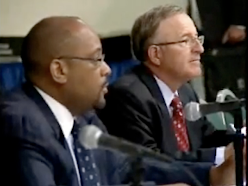
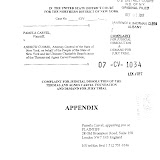


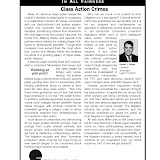

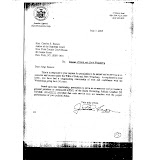
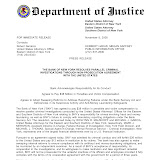
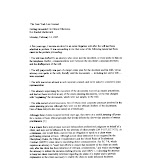

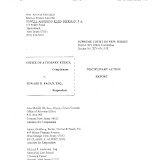
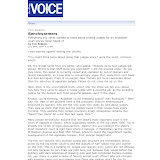

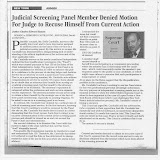

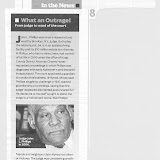
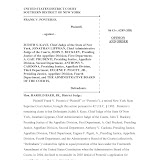
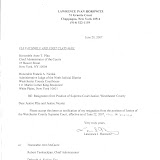
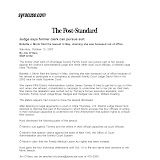
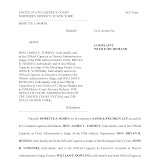

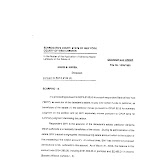
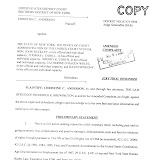

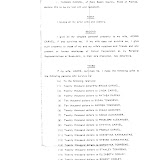
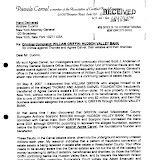
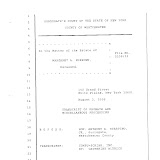
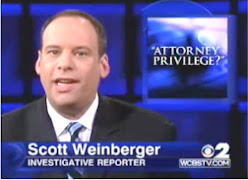
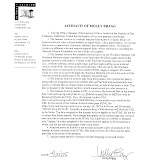
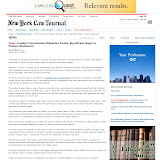
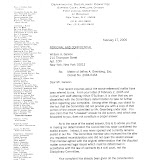
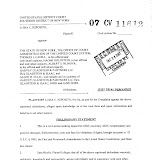
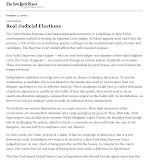
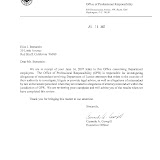
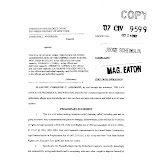
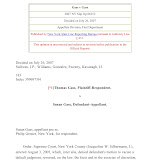
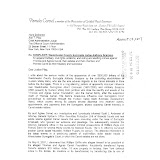

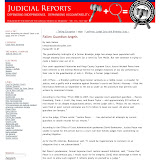


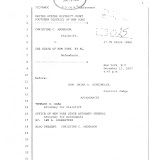
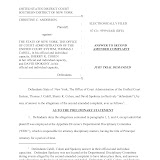
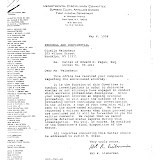
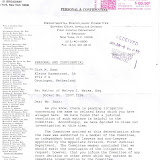
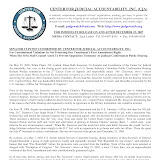

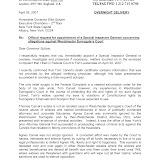
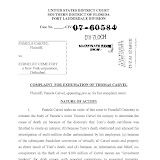
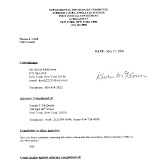
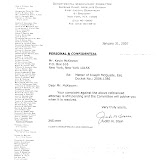
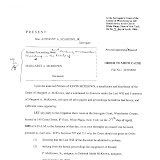
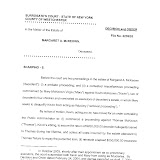
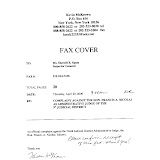
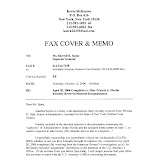
18 comments:
Pay our honest judges DOUBLE. Put our corrupt judges in JAIL.
I heard Walmart is hiring, they should try the mall too if they need extra money. As it appears what they steal I mean earn plus pay off's, kick backs and the money from the child porn industry is not enough.
Hey Bernadette E. Lupinetti, Esq. I guess you are getting the message, remember I too know how to play and soon I will hit you so hard you won't know your right from your left. U-TUBE is a great source to release recordings, you are a pile of human waste endagering the welfare of minors and destroying families. You are worst than a pedophile, prostitute, rapist, drug addict you are a corrupt attorney fixing child custody to sexually exploite children and divorce case to ensure those you know personally win their cases.
Big Time Conflict of Interest!!! The Fix Is In, This Is The Way The CORRUPT SYSTEM Works!!!
The taxpaying grunts don't want to increase the fodder at the judicial trough, when they will receive less. Even worse, they resent the corruption which requires them to call them, your honor, when honor and NY judge are antonyms.
Hey, use this site to any recordings it would be interesting to hear what criminals say, when they don't know they're been recorded.
they got to be judges because paid of the correct party orginization
for permision to run. They were allowed to buy into the election to theses phantom groups. Theses groups use the money to further gridlock and move thier agenda foward. They are already corrupt before they have gotten on the ballot. They are already owned.
they got to be judges because paid of the correct party orginization
for permision to run. They were allowed to buy into the election to theses phantom groups. Theses groups use the money to further gridlock and move thier agenda foward. They are already corrupt before they have gotten on the ballot. They are already owned.
If NY state judges hear 4.5 million cases...mostly criminal...and that is a basis for granting raises...in the narrow window they have to grant them for themselves...because there is no one else to rule for or against them...how convenient...I am then very amused and amazed that these black robe racketeers can find time to leave work everyday around 3 pm...take off at least 2-3 afternoons..plus almost every Friday afternoon, and find it ethical and legal to take weeks and sometimes 4-6 months off...every year!
How does Piggot...whose own judicial district is guilty of what I have described as a staggering abuse...find himself able to write such an outrageous decision?
The only way any judge should be able to secure any raise ....is by requesting theses raises from an unconcerned party....which could exist as a citizen's panel for judicial accountability...where they will assess the abuses now existing within the judicial community and decide if raises are warranted.
If any judicial member does not agree with the above assessment that I have made..please tell the world and state...where and why I am wrong!
Our Judges should strike, walk out now, if they are not part of the corrupt crud they will not survive
Strike Judges Strike
turn the bastards in, make the changes to turn this State around..........
Strike!
some of them are nominated for judgeships because they got the dirt on some official and they use it to their advantage........
disgusting bastards!
Keep posting stuff like this i really like it
Dear Senator George Maziarz,
Please print a memo on how to stalk females. How to use their medical records, the Police, the Da, State Govt Agencies to harm innocent women, just make up as many fake stories as you can and pass them around so you can have a gang stalking event, until they commit suicide,like the last one it was done to.
Since I was stalked in 94-96, by the same tactics, this is all intentional. HATE CRIMES and all the Pigs should be in Prison.
Sincerely yours,
Buttbuster
Dear Fed Guys,
The above blog means this is all a pattern, a pattern of stalking and harming certain residents of Niagara County.
Please do not tell me they are done, they would have investigated and stopped when the last one committed suicide.
My lawyers would have not lied, taken money and committed felonies, oh yeah and threatened me!
Sincerely,
Buttbuster
Retailiate this you lying bastards!
BURN IN HELL!
THANK YOU TO FRANK FOR THIS SITE
they may have been able to shut me up, they are being exposed
some psychotics get away with it for many years until you are allowed to turn them in and then they turn in more and the scheme is exposed!
Fire them all, they should burn in hell in their black robes. We don't need any of them!
Keep posting stuff like this i really like it
Post a Comment